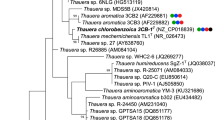Abstract
Acinetobacter sp. YT-02, a Gram-negative bacterium isolated from the activated sludge from a sodium N-cyclohexylsulfamate production plant, has the ability to degrade cyclohexylamine. It was classified as a member of Acinetobacter sp., a Gram-negative bacterium, sharing a 16S rRNA gene sequence identity of 99% with Acinetobacter guangdongensis strain 1NM-4. It could degrade 10 mmol/L cyclohexylamine within 22 h. Based on the identified metabolite, the metabolic pathway of cyclohexylamine could be postulated as it was degraded via cyclohexanone. Draft genome sequence of this strain (2,993, 647 bp of chromosome length) is presented here. We further identified the genes encoding the enzymes involved in cyclohexylamine oxidation to cyclohexanone and the subsequent downstream metabolic pathway of cyclohexanone oxidation. Strain YT-02 has the potentiality to be applied in the treatment of the pollutant cyclohexylamine, and it could also be treated as a research material to study the degradation mechanism of cyclohexylamine.

Similar content being viewed by others
Change history
24 March 2018
The original version of this article unfortunately contained a mistake in the Fig. S1 of supplementary material. It is corrected with this erratum.
24 March 2018
The original version of this article unfortunately contained a mistake in the Fig.��S1 of supplementary material. It is corrected with this erratum.
24 March 2018
The original version of this article unfortunately contained a mistake in the Fig.��S1 of supplementary material. It is corrected with this erratum.
References
Besemer J, Lomsadze A, Borodovsky M (2001) GeneMarkS: a self-training method for prediction of gene starts in microbial genomes. Implications for finding sequence motifs in regulatory regions. Nucleic Acids Res 29(12):2607–2618
Cheng Q, Thomas SM, Kostichka K, Valentine JR, Nagarajan V (2000) Genetic analysis of a gene cluster for cyclohexanol oxidation in Acinetobacter sp. strain SE19 by in vitro transposition. J Bacteriol 182:4744–4751
Delcher AL, Bratke KA, Powers EC, Salzberg SL (2007) Identifying bacterial genes and endosymbiont DNA with Glimmer. Bioinformatics 23(6):673–679
Dhillon BK, Laird MR, Shay JA, Winsor GL, Lo R, Nizam F, Pereira SK, Waglechner N, McArthur AG, Langille MG, Brinkman FS (2015) Island Viewer 3: more flexible, interactive genomic island discovery, visualization and analysis. Nucleic Acids Res 43:104–108
Feng Y, Yang P, Wang X, Zong Z (2016) Characterization of Acinetobacter johnsonii isolate XBB1 carrying nine plasmids and encoding NDM-1, OXA-58 and PER-1 by genome sequencing. J Antimicrob Chemother 71(1):71–75
Fiester SE, Actis LA (2013) Stress responses in the opportunistic pathogen Acinetobacter baumannii. Future Microbiol 8(3):353–365
Gebhardt MJ, Shuman HA (2017) GigA and GigB are master regulators of antibiotic resistance, stress responses, and virulence in Acinetobacter baumannii. J Bacteriol. doi: 10.1128/JB.00066-17
Ho MT, Weselowski B, Yuan ZC (2017) Complete genome sequence of Acinetobacter calcoaceticus CA16, a bacterium capable of degrading diesel and lignin. Genome Announc 5(24):e00494-17
Hyatt D, Chen GL, LoCascio PF, Land ML, Larimer FW, Hauser LJ (2010) Prodigal: prokaryotic gene recognition and translation initiation site identification. BMC Bioinformatics 11(1):119
Iwaki H, Hasegawa Y, Teraoka M, Tokuyama T, Bergeron H, Lau PC (1999) Identification of a transcriptional activator (ChnR) and a 6-oxohexanoate dehydrogenase (ChnE) in the cyclohexanol catabolic pathway in Acinetobacter sp. strain NCIMB 9871 and localization of the genes that encode them. Appl Environ Microbiol 65:5158–5162
Iwaki H, Shimizu M, Tokuyama T, Hasegawa Y (1999) Biodegradation of cyclohexylamine by Brevibacterium oxydans IH-35A. Appl Environ Microbiol 65:2232–2234
Jung J, Baek JH, Park W (2010) Complete genome sequence of the diesel- degrading Acinetobacter sp. strain DR1. J Bacteriol 192(18):4794–4795
Kanehisa M, Goto S (2000) KEGG: kyoto encyclopedia of genes and genomes. Nucleic Acids Res 28(1):27–30
Kroes R, Peters PW, Berkvens JM, Verschuuren HG, de Vries T, van Esch GJ (1977) Long term toxicity and reproduction study (including a teratogenicity study) with cyclamate, saccharin and cyclohexylamine. Toxicology 8:285–300
Kumbhar AG, Narasimhan SV, Mathur PK (1998) Spectrophotometric method for determination parts per million levels of cyclohexylamine in water. Talanta 47(2):421–437
Lagesen K, Hallin P, Rødland EA, Stærfeldt HH, Rognes T, Ussery DW (2007) RNAmmer: consistent and rapid annotation of ribosomal RNA genes. Nucleic Acids Res 35(9):3100–3108
Lai MJ, Soo PC, Lin NT, Hu A, Chen YJ, Chen LK, Chang KC (2013) Identification and characterisation of the putative phage-related endolysins through full genome sequence analysis in Acinetobacter baumannii ATCC 17978. Int J Antimicrob Agents 42(2):141–148
Li X, Li CZ, Mao LQ, Yan DZ, Zhou NY (2015) Complete genome sequence of the cyclohexylamine-degrading Pseudomonas plecoglossicida NyZ12. J Biotechnol 199:29–30
Lowe TM, Eddy SR (1997) tRNAscan-SE: a program for improved detection of transfer RNA genes in genomic sequence. Nucleic Acids Res 25(5):0955–964
Mirza IA, Burk DL, Xiong B, Iwaki H, Hasegawa Y, Grosse S (2013) Structural analysis of a novel cyclohexylamine oxidase from Brevibacterium oxydans IH-35A. PLoS ONE 8(3):e60072
Shen Y, Yan DZ, Chi XQ, Yang YY, Leak DJ, Zhou NY (2008) Degradation of cyclohexylamine by a new isolate of Pseudomonas plecoglossicida. World J Microbiol Biotechnol 24:1623–1625
Yan DZ, Li X, Li CZ, Mao LQ, Chi XQ, Zhou NY, Liu DY (2017) Genome-wide identification and characterization of genes encoding cyclohexylamine degradation in a novel cyclohexylamine-degrading bacterial strain of Pseudomonas plecoglossicida NyZ12. J Biotechnol 251:166–173
Zerbino DR, Birney E (2008) Velvet: algorithms for de novo short read assembly using de Bruijn graphs. Genome Res 18(5):821–829
Acknowledgements
The study was supported by the National Natural Science Foundation Program of China (31270112) and State Key Laboratory of Microbial Metabolism (Shanghai Jiao Tong University) (MMLKF14-06).
Author information
Authors and Affiliations
Corresponding author
Electronic supplementary material
Below is the link to the electronic supplementary material.
Rights and permissions
About this article
Cite this article
Yan, DZ., Gan, YT., Zhou, H. et al. Draft Genome Sequence of Cyclohexylamine-Degrading Strain Acinetobacter sp. YT-02 Isolated. Curr Microbiol 75, 284–287 (2018). https://doi.org/10.1007/s00284-017-1377-9
Received:
Accepted:
Published:
Issue Date:
DOI: https://doi.org/10.1007/s00284-017-1377-9




